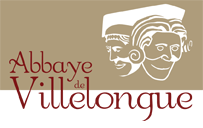
 Friends' Association of the AbbeyWorks - conservation
Sponsorship
Friends' Association of the AbbeyWorks - conservation
Sponsorship
The Founding of the Abbey
 Originally coming from the monastry of Bonnefont en Comminges, a dozen monks come to settle at Compagnes in 1149, north-east of Saissac. Gradually this little community grows and is given land and property in the area of the hamlet of Saint Jean de Villelongue at the foot of the Montagne Noire (Black Mountain).
Originally coming from the monastry of Bonnefont en Comminges, a dozen monks come to settle at Compagnes in 1149, north-east of Saissac. Gradually this little community grows and is given land and property in the area of the hamlet of Saint Jean de Villelongue at the foot of the Montagne Noire (Black Mountain).
As a result of this the monks decide to transfer to Villelongue in the Vernasson valley where the conditions are more favourable. In 1170 the construction of the Cistercian Abbaye Sainte Marie de Villelongue begins on this site.
Power and Decline: 800 years of an eventful history
 Four of the Abbey’s abbots took part in the Albigensian Crusade which was led by Simon de Monfort. As a reward the Abbey of Villelongue received half the dues of Saint Martin le Vieil. It also became proprietor not only of the chateau, but also of the entire village. The King of France Louis IX, (1226-1270) also known as Saint Louis, intervened personally in favour of the abbey on several occasions.
Four of the Abbey’s abbots took part in the Albigensian Crusade which was led by Simon de Monfort. As a reward the Abbey of Villelongue received half the dues of Saint Martin le Vieil. It also became proprietor not only of the chateau, but also of the entire village. The King of France Louis IX, (1226-1270) also known as Saint Louis, intervened personally in favour of the abbey on several occasions.
Through these acquisitions the Abbey was now rich and powerful. Its construction was completed at the end of the 12th century.
The wealth of the abbey, coupled with the desire for further embellishments, marked a second period of building in the 13th and 14th century :
 The abbey church is enhanced by rib-vault crossings; the transept is bathed in light which pours through a magnificent rose window and the large gothic windows
The abbey church is enhanced by rib-vault crossings; the transept is bathed in light which pours through a magnificent rose window and the large gothic windows
The Abbaye de Villelongue is one of the rare Cistercian abbeys to possess such a rich décor.
But difficult times begin with the ravages of the Black Plague and the wars of religion, as well as with the system of the Commende, by which wealthy personnages, rather than elected clerics are appointed as abbots. Soon the land and property are badly managed, financial losses increase and the spiritual life is neglected. When the French Revolution begins there are just three monks left in the by now ruined abbey. The revolutionaries don’t even take the trouble to sack the abbey, as the lack of maintenance has done the work for them. In 1791 the Abbey of Villelongue and all its lands are dispersed and sold as public property.
The Present Day
 1916 - The Abbey is listed by the Office of Historic Monuments ( Monuments Historiques) ;
1916 - The Abbey is listed by the Office of Historic Monuments ( Monuments Historiques) ;
1963 - Doctor André ELOFFE, whose family still lives at the Abbey to this day, acquires the property and begins the work of preserving the buildings.
1985 - The Eloffe family participates in the founding of the Association of the Friends of the Abbey of Villelongue (L’Association des Amis de l’Abbaye de Villelongue). Its aim is to bring the abbey to the attention of the wider public and to be actively involved in its restoration.
“The Abbaye de Villelongue, which had remained closed to the world, is once again looking outward thanks to the preservation of its riches, and without the loss of its intimate character. This surely lies at the heart of its charm.”

